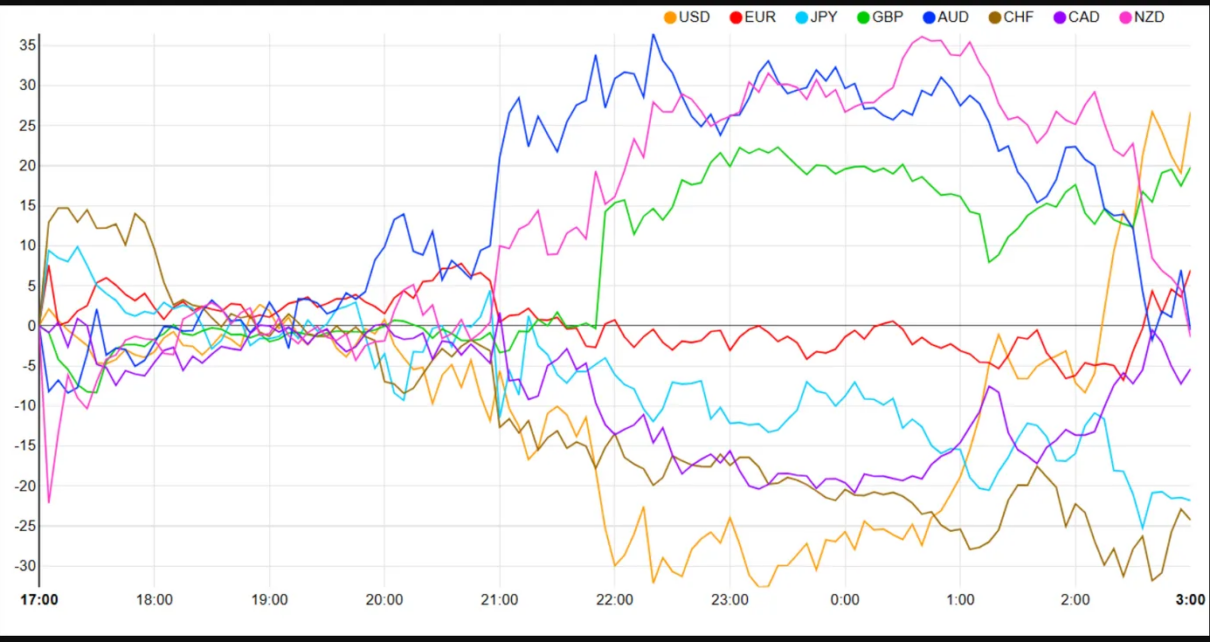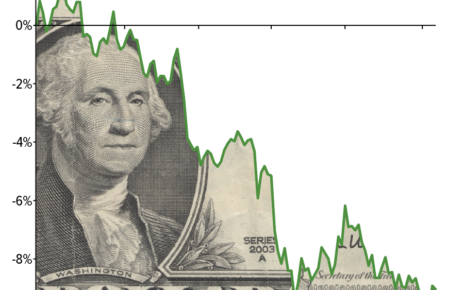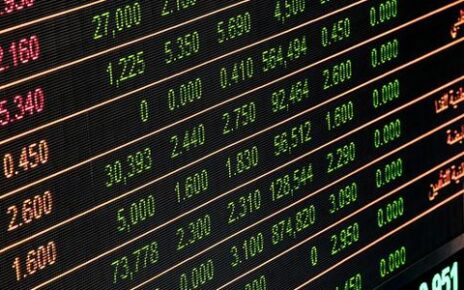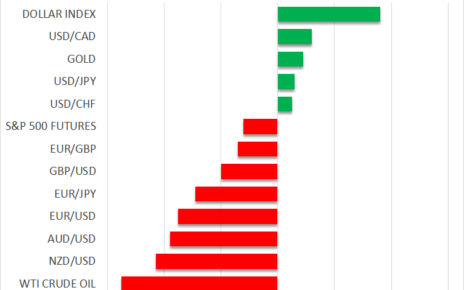Markets rallied and backstopped risk assets on Thursday as investors parsed a fresh volley of headlines that pointed to possible progress on the US-China trade relationship, a potential major deal in the works, and ongoing shifts in the global policy landscape. The day’s price action reflected a blend of optimism around a forthcoming agreement with a likely partner in the United Kingdom, alongside strategic recalibrations in technology export controls and central-bank positioning. As traders weighed the implications for equities, currencies, and commodities, a more risk-on posture appeared to take hold, even as caution persisted ahead of key weekend talks and policy announcements. The net result was a broadly stronger tone across stock-index futures, a soft-yet-steadying US dollar against a basket of peers, and renewed interest in risk assets such as precious metals and energy, all underscored by an overarching sense that policy and diplomacy could converge to lift sentiment in the near term.
Global stocks and futures moved higher as the day progressed, reinforcing a positive mood across equities after President Donald Trump signaled he would unveil a “major” trade deal. The market interpretation centered on the possibility that Washington’s next steps could involve a comprehensive agreement with an important trading partner, with early speculation pointing to the United Kingdom as a likely candidate. In response to Trump’s comments posted on Truth Social, stock-index futures gained breadth and momentum. S&P 500 futures and European stock futures each rose by about 0.8%, signaling broad-based expectations of improved risk appetite and potential gains into the close of trading on other shores. The implication for global markets was clear: a meaningful trade deal could reduce the policy and tariff-related frictions weighing on risk assets and provide a clearer path for corporate earnings to rebound in the months ahead.
In tandem with the trade headlines, another major development supported the stock-market tilt higher. The Trump administration signaled plans to revise a Biden-era rule that had restricted the export of certain advanced AI chips. The stated objective was to adjust export controls to reflect evolving technology landscapes and national-security priorities while preserving strategic advantages for American industry. A spokesperson for the U.S. Department of Commerce outlined the potential changes, which investors interpreted as a move that could unlock greater flexibility for AI companies and related sectors while maintaining safeguards on sensitive technologies. This development was viewed as a potential catalyst for tech stocks and associated sectors, given the central role of AI hardware and software in shaping future growth trajectories.
Nonetheless, President Trump’s comments on the upcoming US-China trade talks introduced a note of tempered caution. He indicated a reluctance to lower tariffs on China as a means to accelerate or broaden substantive trade negotiations with Beijing. The stance suggested that while a trade deal could be forthcoming, it would not be pursued through rapid concessions on tariffs that could undermine leverage in talks. The juxtaposition of eagerness to secure a major deal with a cautious tariff posture created a nuanced market backdrop. Traders weighed the possibility that a deal could still be achieved, but not at the pace or terms that would unlock a more immediate, widespread relaxation of trade barriers. The outcome for markets depended on how forthcoming discussions could align with the administration’s broader strategy on bilateral and multi-lateral trade relationships.
Turning to the currency markets, the appetite for risk-on positioning translated into a mixed but generally supportive environment for major currencies. The British pound advanced, rising as much as 0.5% intraday before stabilizing with a modest 0.2% gain to around 1.3315 in the late session. The move reflected expectations that the Bank of England (BoE) would deliver a 25 basis point rate cut later in the day, with markets pricing in a 4.25% policy rate. However, traders remained attentive to the BoE statement, keen to see whether the central bank would articulate a gradual and careful approach to easing or signal a potentially more decisive shift if inflation pressures persisted or if growth prospects deteriorated. The pound’s modest strength suggested that market participants believed the BoE would manage expectations to avoid unnecessary volatility, even as rate-cut prospects remained central to the near-term narrative.
Elsewhere, the Australian dollar jumped 0.6% against the US dollar, while the New Zealand dollar gained 0.5%. Both currencies retraced some of their gains, with positions trimming to roughly a 0.3% rise by the end of the session. The currency strength picture, as depicted in a widely watched chart, placed USD and GBP among the stronger performers earlier in the day, followed by EUR, AUD, NZD, CAD, JPY, and CHF, illustrating a general risk-on environment but with notable USD resilience against some cross pairs. The currency dynamics reflected a blend of tactical positioning around central-bank expectations, trade developments, and shifting risk sentiment as investors priced in a cautiously optimistic stance toward policy trajectories.
In the commodities complex, crude oil prices remained broadly stable through the session. Brent crude rose by about 43 cents, or 0.7%, to roughly $61.55 per barrel, while U.S. West Texas Intermediate (WTI) crude gained around 49 cents, or 0.8%, to approximately $58.56 per barrel. The quiet move in oil underscored a market awaiting more explicit signals on demand projections and global supply dynamics amid evolving trade discussions and energy-market fundamentals. The absence of a sharp swing suggested traders were consolidating positions ahead of further guidance from policy makers and technical indicators that could shape near-term price levels.
Gold prices slipped modestly from more elevated levels as investors rotated into assets perceived as less risky in a risk-on phase, though the metal remained near the higher end of its recent trading range. The precious metal hovered around the mid-3,300s per ounce, with the 3,340 area cited as a current working level, reflecting the negotiation between sentiment and hedging needs. The overall tone in metals suggested a cautious but constructive approach to diversifying portfolios, with gold acting as a traditional hedge against inflation risks while equities benefited from improved risk appetite linked to trade and policy developments.
Against this backdrop, the Federal Reserve’s posture and the upcoming Bank of England decision loomed large for the broader trajectory of financial markets. The Fed’s recent takeaway from its latest policy meeting highlighted the central bank’s acknowledgment of the risks that higher inflation and higher unemployment could materialize simultaneously. This recognition underscored the possibility that the Fed might adjust its economic projections in June to reflect a more balanced assessment of the macro risk landscape. In the current environment of improving market sentiment, U.S. rates appeared to edge higher in early trading as investors recalibrated expectations in light of this risk assessment and the prospect of a policy stance that accommodates evolving inflation dynamics.
From a data perspective, the week was light on the immediate domestic calendar, with attention shifting to the policy implications embedded in central-bank communications and trade-related headlines. The Bank of England was in focus as traders anticipated a 0.25% rate cut to 4.25%, with the core question centering on how the BoE would frame its easing program. The market was particularly interested in whether the BoE would endorse a more gradual and cautious approach or signal a potential acceleration of easing should inflation and growth dynamics evolve unfavorably. The prevailing view among market participants suggested four 0.25 percentage-point rate cuts within the year, though some expected only three by May, August, and November. If the BoE maintained its cautionary language about gradualism, the pound could face renewed volatility even as the rate-cut cycle remained a near-consensus expectation.
From a technical perspective, the European equity landscape offered mixed signals with a potential bullish tilt on the DAX. The DAX had closed above a key support area around 23,212, which opened the door for a test of fresh all-time highs amid improving sentiment. The market’s focus sharpened on key psychological levels at 23,750, 24,000, and 24,250, which traders flagged as potential resistance or breakout zones depending on the pace and durability of the rally. The move above prior resistance indicated a positive shift in technical momentum, albeit with the caveat that markets would need corroborating data and policy guidance to sustain a sustained advance. Analysts noted that the lack of a long history of price action at new highs could complicate the interpretation of near-term moves, underscoring the importance of monitoring price action near the psychological levels and the potential for volatility if the market encounters supply constraints or risk-off episodes.
In summary, Thursday’s session delivered a confluence of supportive factors for risk assets: signals of a potential major trade deal with a key partner, policy discussions about AI export controls that could balance strategic safeguards with economic openness, and central-bank expectations that framed a cautious but forward-looking stance for inflation, unemployment, and growth. The combination of rising stock-index futures, a stable-to-firmer currency backdrop for the pound and select majors, and steady commodity price action painted a picture of a market positioned for further exploration of upside in the near term, provided that trade talks advance, policy promises translate into tangible actions, and geopolitical tensions remain contained.
Global trade developments and policy signals dominated the narrative in the broader context of the market backdrop. Traders watched with keen interest as President Trump’s remarks hinted at the disclosure of a major trade deal, generating optimism about possible improvements in bilateral ties and cross-border commerce. The anticipation that the deal would be with the United Kingdom, based on sources and market chatter, injected a degree of novelty into the market’s assessment of risk premia and cyclical leadership. The potential UK alignment with US trade policy could have meaningful implications for the UK’s macro trajectory, sectoral composition, and exposure to global supply chains, particularly in areas such as finance, technology, and manufacturing. Given the UK’s economic structure and its evolving relationship with the European Union and the United States, any new agreement would likely influence investor expectations, currency traders’ positioning, and corporate strategies as businesses recalibrate their global footprints.
Separately, the plan to revise a Biden-era rule restricting the export of advanced AI chips underscored the ongoing recalibration of the global technology regime. The Commerce Department’s spokeswoman signaled that changes were being contemplated to bring the regime in line with current technology trajectories and strategic priorities while maintaining safeguards on sensitive technologies. This policy evolution has broad implications: it could potentially expand opportunities for AI developers and hardware manufacturers in the United States while also shaping the competitive landscape internationally. Market participants could interpret these developments as a catalyst for AI-capital-intensive equities, data centers, and related supply chains, even as concerns about national security and technology sovereignty linger. The net effect could be a more dynamic allocation of investment across tech-heavy sectors, influencing sector rotations and the relative performance of growth versus value equities.
Concerning macro policy, the day’s price action underscored the delicate balance market watchers are seeking between accommodative or tightening stances and the risk of policy missteps. The Fed’s candid acknowledgment of inflation and unemployment risks suggests that any shifts in the June projections could reflect a more nuanced stance, potentially supporting a measured path toward longer-run stability rather than abrupt policy changes. Investors remain attentive to the language the central bank uses in its communications, especially phrases that hint at timing, pace, and the degree of policy support or tightening required to achieve the dual mandate. Meanwhile, the BoE’s expected 0.25% cut and its narrative around gradualism could shape the pound’s trajectory, particularly if inflation trends evolve in ways that debilitate or bolster growth expectations. If the BoE remains steadfast in its gradual approach, the pound could be tempered by a cautious stance, even as rate relief supports equity markets and stimulates some segments of the economy.
In terms of market positioning, the day’s moves reflect a nuanced interplay among equities, currencies, and commodities. Equities extended gains in response to expectations of improved trade relations and improved policy clarity, while the dollar demonstrated resilience amid a broader risk-on uplift. The oil complex remained steady, with supply-demand dynamics taking a backseat to policy signals and sentiment in the near term. Gold’s retreat from higher levels signaled a tilt toward risk assets and the repricing of safe-haven demand in an environment where traders are evaluating the pace and scale of policy normalization and the potential for a more favorable macro environment. Taken together, the market narrative centers on a possible turning point that could set the stage for a longer stretch of constructive sentiment if trade talks converge and policy frameworks align with improved economic activity.
As investors navigate the coming days, several themes are likely to shape trading. First, the outcome of the upcoming US-China discussions will be pivotal, potentially determining whether tariff tensions ease or remain a source of volatility. Second, consumer sentiment, business investment, and manufacturing indicators will be scrutinized for clues about the trajectory of growth and inflation, influencing bets on rate paths and asset allocation. Third, any concrete steps around AI chip exports will be closely watched for their impact on technology equities and broader risk assets. Finally, the BoE meeting and Fed communications will continue to influence cross-asset dynamics across equities, currencies, and commodities, guiding traders toward a cautious but opportunistic stance as policy settings gradually normalize.
Conclusion
Thursday’s session underscored a market environment shaped by a blend of optimism around a potential major trade deal, strategic shifts in technology export policy, and a cautious but constructive view on central-bank policy. Stock-index futures and global equities responded to the Trump-related news with gains, while the pound and other major currencies fluctuated in response to anticipated rate cuts and policy language. The energy complex held steady as traders awaited more explicit signals on demand and supply, and gold traded near key levels that reflect ongoing risk considerations and hedging needs.
With the market balanced between risk-on sentiment and policy-driven uncertainty, investors are likely to monitor several developing threads in the days ahead. The prospect of a UK-US trade alignment could have meaningful implications for currency markets and sector performance, while discussions around AI chip exports may influence technology-sector valuation and supply-chain strategies. Central-bank communications—particularly the June projections from the Federal Reserve and the BoE’s guidance on easing—will be critical for setting the tone in markets. The DAX and other European indices will also be of interest as technical momentum interacts with macro signals and expectations for continued growth.
As this landscape evolves, market participants will be looking for confirmation of concrete policy steps and tangible progress in trade negotiations. The coming weekend’s talks and the evolving policy dialogue will help determine whether the themes that defined Thursday’s session translate into a sustained trend or give way to renewed volatility. Investors should remain cognizant of the risks surrounding geopolitical developments, tariff policy, and evolving regulatory regimes, while positioning portfolios to balance potential upside with the prudent management of downside risk. The overarching takeaway is that a potentially meaningful trade agreement, coupled with policy adjustments and a measured central-bank stance, could provide a favorable backdrop for risk assets in the near term, with the potential for a more resilient market environment as the year progresses.



